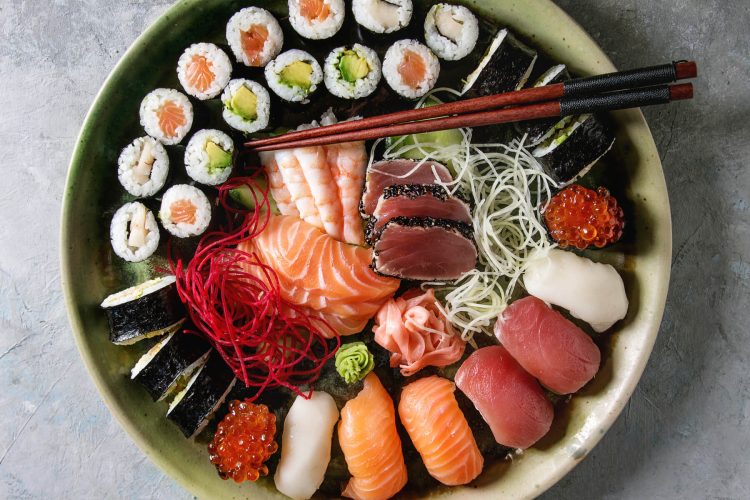The History and Cultural Significance of Sushi in Japan
Sushi, a culinary art form that has become synonymous with Japanese cuisine, has deep historical roots and a rich cultural significance. It is far more than just a dish—sushi embodies the history, traditions, and philosophy of Japan. The origins of sushi can be traced back to ancient Japan, evolving over centuries from a preservation technique to the refined form of sushi that we recognize today.
Sushi’s earliest incarnation dates back to the 8th century during the Nara period, when it was used as a preservation method for fish. Fish was fermented with rice to preserve it, and the rice was discarded after fermentation. Over time, the practice evolved, and the rice itself became part of the dish, eventually leading to the creation of nare-zushi, the ancestor of modern sushi. During the Edo period (1603-1868), sushi as we know it today began to take shape. In the bustling city of Edo (now Tokyo), nigiri-zushi—hand-pressed sushi—was developed. This was a significant shift from earlier forms, which had often been based on rice and fermented fish.
As Japan entered the Meiji period (1868-1912), sushi further evolved, influenced by technological advancements and the opening of Japan to Western trade. The development of refrigeration and refrigeration techniques allowed for the preservation and transportation of raw fish, expanding sushi beyond the local neighborhood sushi shop to the international stage. This evolution in technology not only revolutionized sushi’s accessibility but also reinforced its connection to Japan’s identity as a forward-thinking nation that balanced tradition with modernity.
Sushi’s cultural significance transcends its culinary components. It reflects values such as seasonality (shun), respect for nature, and attention to detail. For the Japanese, sushi isn’t merely food; it is a symbol of artistry, craftsmanship, and connection to the land and sea. The precision with which sushi is prepared, from the selection of fish to the creation of perfectly seasoned rice, speaks to the reverence for nature and the pursuit of perfection inherent in Japanese culture.
The act of enjoying sushi is often an intimate experience, reflecting the importance of social harmony in Japan. In traditional sushi restaurants, customers sit at the counter where they can interact directly with the sushi chef (itamae), creating a sense of community and a connection between the chef’s artistry and the diner’s enjoyment. Sushi is also central to many cultural rituals and ceremonies, from weddings to New Year’s celebrations, underscoring its role in both everyday life and special occasions.
Different Types of Sushi and Their Regional Styles
Sushi is a versatile and diverse dish with many regional variations, each offering unique flavors and textures. While many people are familiar with nigiri and maki, sushi’s complexity goes far beyond these types. Japan’s regional differences have shaped sushi into a variety of styles, each with its own history and cultural influence.
- Nigiri-zushi
Nigiri is perhaps the most iconic form of sushi, consisting of a small mound of vinegared rice topped with a slice of raw fish or seafood. This style of sushi is said to have been developed in Edo (now Tokyo) during the Edo period and is characterized by its simplicity and elegance. Common toppings for nigiri include tuna, salmon, shrimp, and eel, but the possibilities are vast. - Maki-zushi
Maki sushi consists of vinegared rice and fillings, such as fish, vegetables, or egg, rolled in a sheet of nori (seaweed). It is then sliced into bite-sized pieces. While maki sushi is often associated with California rolls or other Western adaptations, traditional maki varieties like hosomaki (small rolls) and uramaki (inside-out rolls) are still prevalent in Japan. - Temaki
Temaki is a cone-shaped sushi roll, typically made by rolling the rice and fillings in a sheet of nori. It is often eaten by hand and is less formal than other types of sushi, making it a popular choice for casual gatherings. - Chirashi-zushi
Chirashi, or “scattered sushi,” is a bowl of sushi rice topped with a variety of sliced fish, vegetables, and garnishes. Unlike other forms of sushi, chirashi offers a more relaxed approach to sushi, allowing for a wide range of flavors and textures to be combined in one dish. It’s a particularly popular choice in regions like Kyoto. - Oshizushi
Oshizushi, or pressed sushi, originates from the Kansai region (which includes Osaka). It involves pressing layers of vinegared rice and fish into a mold to create rectangular blocks of sushi. This style of sushi is not only visually striking but also showcases the regional ingenuity that defines Japan’s sushi culture. - Inari-zushi
Inari-zushi consists of vinegared rice wrapped in sweetened fried tofu pockets. While this style is less common in high-end sushi restaurants, it is popular for festivals, picnics, and casual dining. The tofu pockets are typically slightly sweet, providing a delightful contrast to the vinegared rice.
Each region in Japan has its own twist on sushi, often using locally available ingredients or preparing sushi in a distinctive style. For instance, Osaka is known for its oshizushi, while Hokkaido (in the north) is famous for its fresh seafood, particularly salmon and crab. Kyoto, the cultural heart of Japan, is known for its delicate and refined sushi, including the artful chirashi-zushi.
The Art of Sushi-Making and Etiquette
Sushi-making is an art that requires years of training and dedication. The craftsmanship behind sushi is part of what makes it so special and revered in Japan. The sushi chef, or itamae, is responsible for ensuring that each piece of sushi is perfectly made, from the preparation of the rice to the careful selection and cutting of the fish. It’s a delicate balance of skill, knowledge, and experience, honed over many years.
The preparation of sushi rice, known as shari, is critical to the quality of the sushi. The rice is seasoned with a mixture of rice vinegar, sugar, and salt, and the texture and temperature must be just right. The fish or seafood must be handled with great care, ensuring that it’s sliced in such a way that highlights its natural texture and flavor. The role of the sushi chef is not just to assemble the ingredients but to create an experience that highlights the beauty of simplicity and balance.
Sushi etiquette is also an important part of the culture. In traditional sushi restaurants, diners are expected to eat sushi quickly after it’s served to ensure that the rice remains warm and the fish remains fresh. When eating nigiri, it’s considered polite to pick it up with your fingers (though chopsticks are acceptable), and you should eat it in one bite. If you dip the fish in soy sauce, it should be done with care, avoiding getting the rice wet, as this could overpower the delicate flavor of the fish.
Sushi is often enjoyed with wasabi and pickled ginger, both of which serve distinct purposes. Wasabi provides a spicy kick that enhances the flavor of the fish, while pickled ginger acts as a palate cleanser between different types of sushi.

Top Sushi Spots: Tokyo, Osaka, Kyoto
Japan is home to some of the best sushi in the world, and there are a few cities that are particularly renowned for their sushi culture.
- Tokyo
Tokyo is the epicenter of sushi culture and is home to many of the country’s most famous sushi restaurants. The city boasts several Michelin-starred sushi establishments, including the legendary Sukiyabashi Jiro. For a more casual experience, the Tsukiji Outer Market (formerly the site of the Tsukiji fish market) is a fantastic destination to sample fresh sushi and other seafood. - Osaka
Osaka is known for its more casual and laid-back approach to sushi, particularly oshizushi, or pressed sushi. The city has a thriving street food scene, and you can find excellent sushi at kaiten-zushi (conveyor belt sushi) restaurants, where sushi is served on rotating trays. For a more refined experience, head to Sushitetsu, a renowned sushi restaurant in the heart of Osaka. - Kyoto
Kyoto is the cultural and historical heart of Japan, and its sushi is known for its simplicity and elegance. Kyoto-style sushi, or kyo-zushi, features delicately prepared fish served with a lighter touch. For an unforgettable experience, visit Sushitetsu Kyoto for a taste of traditional sushi in an intimate, serene setting.
Travel Tips for Enjoying Sushi Like a Local
To truly enjoy sushi like a local in Japan, it’s essential to immerse yourself in the customs and culture surrounding this dish. Here are some tips to make the most of your sushi experience:
- Order Omakase
For a truly authentic experience, order omakase—a chef’s tasting menu where the chef selects the sushi based on the best ingredients available that day. This allows you to sample a variety of sushi and enjoy the chef’s expertise. - Don’t Overload on Soy Sauce
While soy sauce is an integral part of sushi, it should be used sparingly. Dipping your sushi rice into soy sauce can overpower the flavors, so instead, dip only the fish. - Avoid Mixing Wasabi Into Soy Sauce
Mixing wasabi into soy sauce is considered disrespectful in traditional sushi etiquette. Instead, apply a small amount of wasabi directly to the sushi before eating it. - Respect the Chef
Engage with the sushi chef by showing appreciation for their craft. It’s customary to compliment the chef’s work, especially if you are enjoying a piece that particularly impresses you. - Eat Quickly
Sushi is best enjoyed fresh, so try to eat each piece quickly after it’s served. This ensures that the rice remains warm, and the fish stays at its optimal freshness.
Conclusion
Sushi is more than just a dish—it is an embodiment of Japan’s cultural identity, history, and philosophy. From its humble beginnings as a preservation technique to its modern-day form as an artful and sophisticated cuisine, sushi has evolved while maintaining its connection to Japan’s roots. Whether you’re enjoying sushi in Tokyo, Osaka, or Kyoto, the experience is a testament to the artistry and craftsmanship of the sushi chef. For those who wish to truly understand Japan’s culture, a deep dive into its sushi tradition is an essential journey.





















